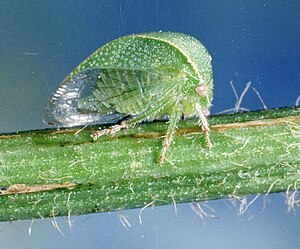Spissistilus
| Spissistilus | ||||||||||||
|---|---|---|---|---|---|---|---|---|---|---|---|---|

Spissistilus festinus (Say) |
||||||||||||
| Systematics | ||||||||||||
|
||||||||||||
| Scientific name | ||||||||||||
| Spissistilus | ||||||||||||
| Caldwell , 1949 |
Spissistilus is a genus of the humpback chirps from the subfamily of the Smiliinae and is widespread in the Neotropics (especially from Argentina) and in the Nearctic , the species has also been introduced in areas of the oriental region.
Eleven species of the genus are known:
- S. chaocoensis Remes-Lenicov, 1973 from Argentina
- S. cornutus (Fowler, 1895) from Panama and Guatemala
- S. discolor (Fairmaire, 1846) (= Ceresa discolor ), Brazil, Peru and Mexico
- S. femoratus (Fairmaire, 1846), from Mexico, Canada and the USA
- S. festinus (Såy, 1830), widespread. Known from Costa Rica, Brazil, Guatemala, Honduras, Mexico, Panama, Caribbean Islands, Cuba, Haiti, Puerto Rico, Canada, USA, Hawaii (introduced) and Bermuda. Important pest on various crops.
- S. nigricans (Van Duzee, 1914), USA
- S. occidentalis (Funkhouser, 1915), USA
- S. puncticeps (Stål, 1864) (= Ceresa colon or C. puncticeps ), Argentina, Bolivia, Brazil, Mexico, Suriname, Uruguay, Canada, USA.
- S. rotundatus (Stål, 1869), Mexico, Cuba, Haiti, USA
- S. spinosus Remes-Lenicov, 1973, Argentina
- S. uniformis (Fairmaire, 1846), Mexico, Cuba, USA
The cicadas of this genus are about 5 to 9 mm long. Lively, they are mostly green, often with brown or light lines on the edges of the pronotum, but dried specimens in collections are mostly brown. The pronotum is more or less helmet-shaped, with a point backwards and two lateral thorns in front. However, one can only reliably assign species to the genus if one examines the male genital structures. A similar habitus can also be found, for example, in the genera Ceresa , Stictocephala , Stictolobus , Tomogonia and Vestistilus .
Way of life: The adult cicadas of this genus live solitary on plants of different families whose phloem they drink. The nymphs are often found in aggregations. Communication with the help of substrate vibrations has been examined in particular in S. festinus , but can also be assumed in the other species.
Web links
Individual evidence
- ↑ Treehoppers: Aetalionidae, Melizoderidae, and Membracidae (Hemiptera). Retrieved January 18, 2018 .
- ↑ McKamey SH: Taxonomic catalog of the Membracoidea (exclusive of leafhoppers). In: Memoirs of the American Entomological Institute . tape 60 , 1998, pp. 1-377 .
- ↑ a b c G. S. de Andrade: Novas combinacoes e sinonimia em Spissistilus Caldwell (Hemiptera, Auchhenorrhyncha, Membracidae) . In: Revista Brasileira de Zoologia . tape 21 , no. 1 , 2004, p. 43-44 .
- ^ A b c d C. Godoy, X. Miranda & K. Nishida: Treehoppers of tropical America . Instituto national de Biodiversidad, Santo Domingo de Heredia, Costa Rica 2006, ISBN 9968-927-10-4 , pp. 352 .
- ↑ LL Deitz, MS Wallace: Richness of the Nearctic Treehopper Fauna (Hemiptera: Aetalionidae and Membracidae) . In: Zootaxa . tape 3423 , 2012, p. 1-26 .
- ↑ Brendan A. Beyer, Rajagopalbabu Srinivasan, Phillip M. Roberts, Mark R. Abney: Biology and Management of the Threecornered Alfalfa Hopper (Hemiptera: Membracidae) in Alfalfa, Soybean, and Peanut . In: Journal of Integrated Pest Management . tape 8 , no. 1 , January 1, 2017, doi : 10.1093 / jipm / pmx003 .
- ↑ Get to Know the Three-cornered Alfalfa Hopper, a (Maybe) Serious Crop Pest . In: Entomology Today . May 5, 2017 ( entomologytoday.org [accessed January 18, 2018]).